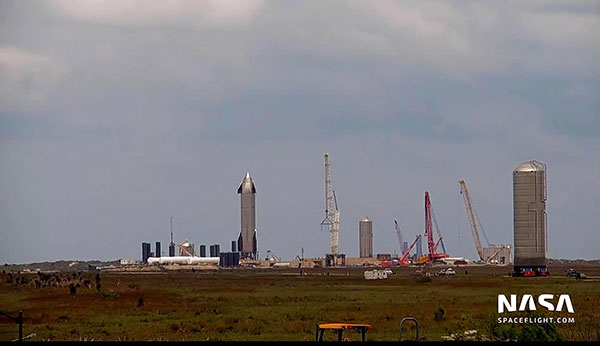Greetings from Palmia Observatory
We have been following a lot of activity around Starship SN15 in Boca Chica and are trying to see if flying down there to watch the launch will fit into our schedule.
The static fire test is thought to be scheduled for Wednesday with the test hop to come several days after that. But there are often delays and it is hard to predict when the launch will occur and then you have to decide if you want to just hang out in Boca Chica area, stay on South Padre Island, and just lay about in the sun and drink margaritas. Hmm, that doesn't sound too bad, but it would be nicer, and less expensive, if we could get a better estimate of the launch date. Hotel rates are about twice as high on the weekend. Some tweeters say that no Starship, with 3 raptor engines, has launched earlier than six days after the static fire test. But that would put the launch date next week, which would conflict with our other travel plans, so maybe we will just wait for the next Starship launch.
 |
| Starship SN15 stands among cranes and ground support equipment (Source: Nasaspaceflight.com) |
Anyway, while waiting for the APS April meeting to come online, this article in April 9 edition of Science described how magnetars could be the source of gamma ray bursts (GRB). A magnetar is a super magnetized neutron star with magnetic field about 1000 times larger than regular neutron star.
We learn in this article that about 2/3 of observed GRBs have durations in the 10 - 100 second range and the other 1/3 are much shorter duration in the range of two seconds or less. The leading explanation is that the high magnetic fields focus some release of plasma, caused by surface rearrangement, a starquake if you will, near the magnetic poles, causes an intense beam of focused energy to be emitted.
 |
| Magnetar flares as source of gamma ray bursts (Source: J. Sokol, Science, April 9) |
Some of the details are contained in the 2nd page of the article.
 |
| How magnetars erupt! (Source: J. Sokol, Science, April 9) |
Ok, the APS April 2021 meeting is finally online. I still find that I am a little "zoomed out" and have a harder time staying alert and active now that I am not physically present at the meeting. But, I can report on two sessions that I made it through so far. First up was the plenary session with the three Nobel prize winners for their work in black holes. My comments here follow the presentation by Sir Roger Penrose, who was not an experimentalist, but laid the mathematical foundation for explaining how general relativity predicts that the compact object that is accreting more and more material must ultimately collapse to a black hole with a singularity.
Roger Penrose proved all of this mathematically back in 1965 and he used this diagram from that paper to let us in again on how the collapse process results in a singularity. No, I am not going to go through all of the details. The explanation sort of made sense as he described why it happens, but I will have to go back to his original paper for the details.
 |
| The diagram explaining the necessary collapse to a black hole (Sir Roger Penrose, APS April 2021) |
The original paper is an important piece of work explaining how black holes must have a singularity if general relativity is correct, but I was more interested in some of Sir Roger's speculations and explanation about the history of the entropy of the universe.
Consider the top row of boxes in the screenshot below. Time moves to the right. If a collection of particles of gas, in a box in our laboratory, is initially confined to the lower right corner and then allowed to expand, the gas will expand to fill the entire box. The entropy just increases continuously throughout this process.
Now consider what happens when we include the effects of gravity. The bottom row of boxes shows this condition. Because of some initial slight density differences, the gas begins to gravitationally collapse. The situation of collapse is illustrated as we move to different times in the boxes to the right. What we notice now is that the end result, with gravitational collapse, is that the entropy has just kept increasing. So, even though the end situation looks like the initial, low entropy condition of the upper left box, the end state as show in the bottom right box is a higher entropy condition. Gravitational collapse results in higher entropy.
The secret is the effect of gravity and the gravitationally collapse results in higher entropy. This is why black holes can have some of the highest amounts of entropy of anything else in the universe. That is pretty neat and for the first time, I can see that black holes ought to have a lot of entropy even though they are very much more compact that the original ball of gas from which they came.
 |
| Box of gas model used to show increasing entropy with time (Sir Roger Penrose, APS April 2021) |
Roger also did some speculating about the nature of the big bang. He says there is not enough evidence to identify what really went on at the big bang, so he speculates about other possibilities including that what we think of the big bang was but one sort of big bang and that evidence of other big bangs might be observable in the CMB or other tests.
 | |
|
 |
| Does CMB really come from asteroids in the Oort cloud? (Source: T. Prevenslik, APS April 2021) |
Say What! This is a crazy sounding idea, but let's look into this idea a little bit. Could the hot spots shown in the image actually come from small objects like asteroids. We can estimate the apparent size of an asteroid with just a little trigonometry. Suppose the asteroid is about as big as Vesta, approximately 300 miles in diameter. Then at 10,000 AU distance, that object would extend an angle of about arctan (300 / (10,000 * 93,000,000) ) = 0.000000000322 degrees or about 0.001 milliarcseconds. So, objects this small are not likely to show up in an image of 2.5 by x.5 degrees. So, you would need a camera with something like 8 billion pixels by 8 billion pixels just so the asteroid would show up in just one pixel. So, it is not likely that the Planck satellite would see the heat from one asteroid at that distance.
Can we say anything about the temperature of objects in the Oort cloud? Since the temperature depends on the distance from the sun, we can make some assumptions and just scale up the temperature for asteroids in the asteroid belt and apply further distance from the sun to get an estimate of the similar object located in the Oort cloud. If a solar system asteroid, like Vestas, is around 175 K average, let's use that as a basis for estimated Oort cloud object temperatures. The amount of solar radiation will be (2.5 / 10,000)^2 less at the Oort cloud. If the asteroids there only have a temperature based on radiation from our sun, my estimate is that their temperature would be about 2.8 K. In reality they can be a little hotter because of other radiation sources.
So, we don't accept the proposal that the CMB measurements come from the Oort cloud. The observed Planck anisotropy, once corrected for nearby sources, is not likely due to asteroids in the Oort cloud because the CMB comes from a much further distance away. But, we know that foreground objects, between us on Earth and that far away last scattering surface, will show up in the CMB image and must be removed in order to see the real anisotropy of the universe. For instance check out this Planck image of the measured CMB, before some of the foreground sources have been removed. You can see the Large and Small Magellanic Clouds (LMC and SMC).
Now the LMC is around 160,000 light years from us and has a diameter of about 14,000 lightyears, so its apparent size on the night sky is arctan (14 / 160) = 5 degrees. This is the kind of detail and resolution that shows up in Planck images. Nothing close to the proposal that the asteroids in the Oort cloud are what show up in Planck images.
This ESA image includes the LMC and the SMC. The vortices are just instrumental error but bright flows at the top of the image represent light from interstellar dust between us and the LMC. To examine the anisotropy of the early universe all of these foreground sources have to be removed, as has been done in the plots we see showing the average background temperature of the whole sky.
 |
| The LMC and SMC as seen in CMB background by Planck satellite (Source: ESA) |
Other details about the Planck image can be found at: https://sci.esa.int/web/planck/-/57995-the-magellanic-clouds-and-an-interstellar-filament.
I had pretty much forgotten about the LMC and the SMC until this Planck image showed up, but I still remember who lucky we were to actually see the LMC and SMC with our own eyeballs when we visited Easter Island after watching the 2017 total solar eclipse from Chile. My images of the clouds, taken with DSLR and flimsy tripod, and the backstory can be found at: http://www.palmiaobservatory.com/2019/07/post-eclipse-adventure-on-rapa-nui.html
Until next time, here from our burrow, stay safe, as we recover more of our freedom,

No comments:
Post a Comment